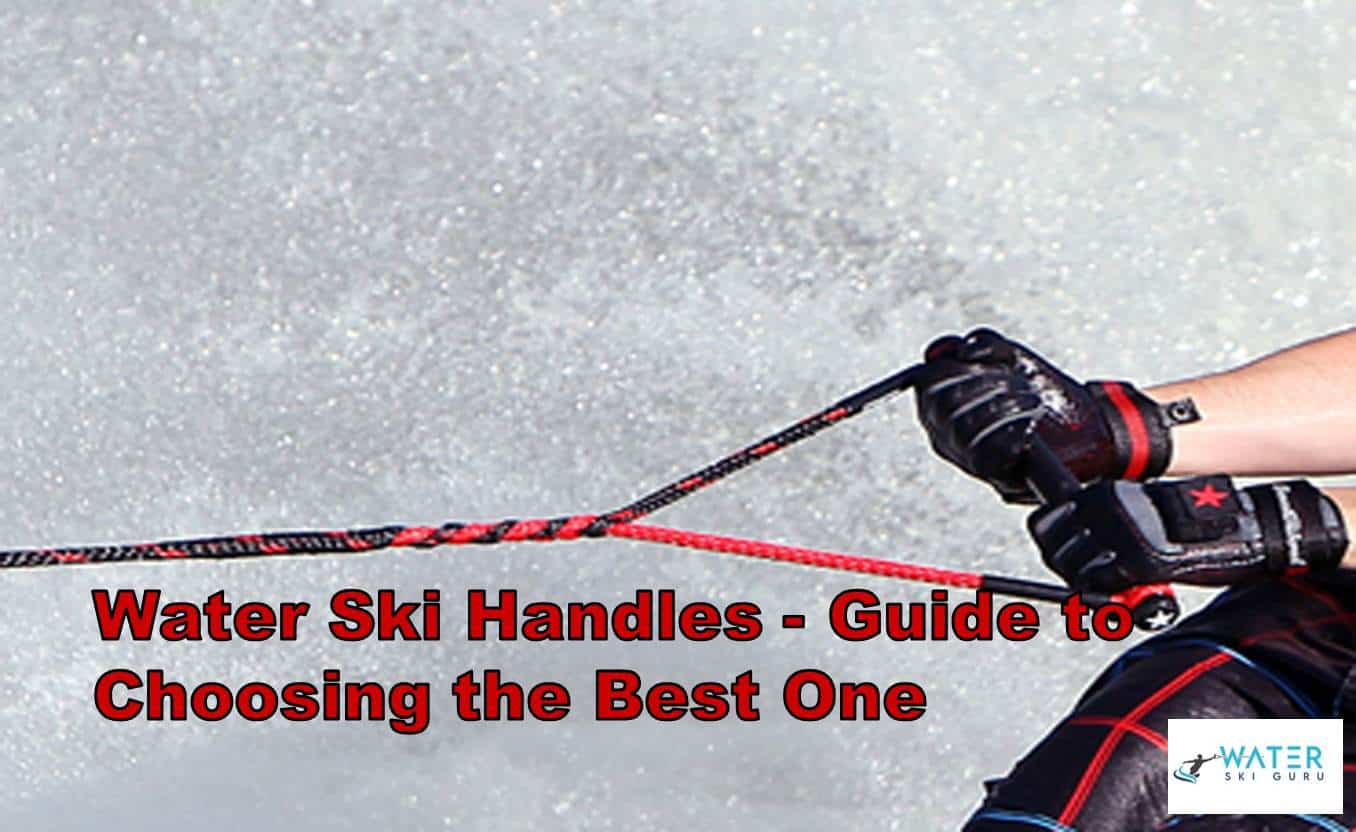A good water ski handle should be comfortable and lightweight, while providing a solid grip to help maintain control as you execute turns and other maneuvers. Important factors include the handle size, grip construction, and safety features like finger guards. Specialty handles are available for slalom skiing, wakeboarding, and trick skiing.
In this blog post we will discuss how to select the best water ski handle and much more to ensure your time on the water is enjoyable!
Important Features to Look for in a Water Ski Handle
Not all water ski handles are the same. Some water ski handles are designed for slaloming, others for wakeboarding and yet more for trick skiing. So what features should you be looking at when choosing the right water ski handle?
Important factors to consider when buying a water ski handle are:
- Materials of construction
- Size
- Ergonomics and comfort
- Grip design
- Finger guards
Feature #1 – Materials of Construction
Besides your skis and the boat, the ski handle is the most important piece of gear you’ll use. Don’t skimp by purchasing one made of cheap materials.
The handles on water ski ropes are usually made from aluminum wrapped in rubber to create a comfortable grip. You’ll want one that floats so if you need to let go some reason, it will be easy to find. This is especially helpful when you’re getting set up to start your run.
Feature #2 – Handle Size
The water ski handle should not be too long for you to use comfortably. It is better if it’s a little short than too long so your joints and muscles don’t become overworked from the strain of holding up such a heavy load at arm’s length.
You also want to find one with a handle diameter that fits in your hand. Most handles have the same diameter, but you can find some that are larger or smaller if you check around.
The typical water ski handle diameter is 1-inch. You can find handles with diameters ranging from 0.88-inches to as large as 1.25-inches.
Feature #3 – Ergonomics and Comfort
The water ski handle should have a design that makes it easy to grip. It should be comfortable in your hand, with enough room for all of your digits to fit on it comfortably. The handle diameter should also allow you to fully grip the bar without over-stretching your fingers.
This will ensure you can maintain control and keep a solid grip while you’re executing turns on a slalom course or jumping the wake while skiing.
Feature #4 – Grip Design
The rubber that covers the handles should be designed with comfort in mind to reduce hand fatigue while skiing. It should also have a textured surface so you have a good grip without having to hold it too tightly.
The rubber should be bonded to the handle to avoid slipping while you’re holding it. It should be thick enough to allow some compression when you grip it, but not too much. Otherwise, the handle will move around in your hand, making it harder to maintain control.
You don’t want your fingertips digging into your palm around the handle. It’s a fine line between too soft and too firm.
Feature #5 – Finger Guards
To avoid pinched fingers, look for a ski rope with finger guards. Finger guards keep your fingers from being squeezed between the handle and the ski rope.
Look for guards that are made of plastic to give a little flex when your hand rubs against it. Avoid handles with cheaply made, thin finger guards. They won’t last long with all of the wear and tear involved with water skiing.
Water Ski Handle Design and Configuration
There are many different ways to water ski and just as many water ski handles.
Water ski handles come in several configurations.
- Straight handle: The straight handle is the most common type of water ski handle out there. It consists of a tube that is 12 to 13 inches long with a length of rope that connect to the main ski rope. A water skier might use a regular handle if they’re used to water skiing but want the added challenge of slaloming.
- Double-handle pull: Water skiers have different preferences and some like the double-handle pull better than a regular handle. If you prefer this style of pulling, be sure to purchase water ski rope that has this feature on it!
- Deep V handle: This type of handle is great for teaching people to do a deep water start. This configuration has a deep, wide opening that helps keep the skis in position and pointing forward during the start.
- Slalom handle: The slalom handle is designed specifically for slalom skiing. They are usually lighter to help with quick transitions and switching hands. They also are built to minimize rope roll to help you to perform your best!
- Surf style: Surf style handles are popular among water ski instructors because it enables them to give students more pulling power and control in choppy, rough conditions. It also offers greater pulling power.
- Radius handle: This type of handle is good if you have any type of elbow pain. However, from strictly a leverage and skiing point of view, straight handles do better because you can keep your arms in closer to your body.
Which water ski handle design is best?
It really comes down to putting on your gloves and just seeing which handle suits you best. I’ve had good luck visiting the local pro shop and checking out their selection. There are a lot of options to choose from these days.
Good luck with your decision!
Water Ski Handle Diameter
The thickness of the handle should be based on how long your fingers are. The shorter your fingers are, the smaller diameter handle you’ll want.
Smaller diameter ski handles are easier to hold on to. They are also rougher on your hands, especially if you don’t wear glove.
Larger diameter handles take more grip, but they’re much easier on your hands.
As a general rule, women and children should use a handle with a diameter less than 1.00-inch. Men usually do well with a handle diameter between 0.900 and 1.09-inches.
People with large hands look for something bigger than 1.09-inches.
Water Ski Handle Length
Water ski handles come in several lengths – also known as size. Ski handles range from 12 to 13 inches.
The handle size (12 versus 13 inches) has a considerable impact on body position and movement. There is also a lot of personal preference involved in selecting the handle size? What handle do you use?
In general, the taller you are, the larger your handle should be. Unless you are very tall, you should be using a 12-inch wide handle.
The official regulation size slalom ski handle specifies a handle length of 11-13/16″ +/- 2-3/8″. This means the handle can be as short as 9-7/16″ and as long as 14-3/16″.
Water Ski Handle – Proper Grip Technique
There are several theories about what is the best grip to use for water skiing. Among slalom skiers, you’ll find a lot of very strong opinions and a lot of different advice.
In my opinion, there are two things that matter most – your grip and palm position. Let’s review what these are.
1 – Baseball Bat Grip
Grip position refers to how you hold the ski handle. This is an important part of your technique, and you want to get it right. I find that the baseball bat grip works best for most skiers.
Hold the ski handle like you would a baseball bat. With this grip, you will have one palm facing up and one facing down. The handle should feel comfortable and “natural” in your hand.
This will give you the strongest grip. It also reduces fatigue, which is especially important if you slalom ski.
2 – Forward Foot and Palm Position
When you grip the handle, which palm should be facing up? This is a very important question. And you want to get it right because this definitely helps with your offside turns.
The best way to grip the ski handle depends on which foot you put forward.
Left foot forward (LFF): If you ski with your LFF hold the handle with your left palm up. You’ll also want to start with your ski pointed to the right and the rope on the left side of your ski. If I could ever ski like him I’ll say I reached much more than I could count on.
Right foot forward (RFF): For those of you who ski RFF, hold the handle with your right palm up. For deep water starts, your ski should be on the left side of the rope. Point your ski to the left.
3 – Switching Your Handle Grip
The correct grip for skiing will help you with your toeside turns. This is because the handle on which you hold it can be moved closer to your hip, so that when a sudden deceleration occurs at the end of an offside/toeside turn, it won’t require as much arm strength in order not break at the waist or extend too far out from one’s body.
If you end up switching your grip, be sure to practice. I switched a few years back. To make it easier, I made the change in the off season. I practiced the new position by leaning on a pole. By spring It felt pretty normal.
Final Thoughts on Water Ski Handles
Having the best water ski handle for your type and style of skiing is important. You want a high-quality handle, with a good grip and ergonomic design. You need a handle that is the right size and optimum diameter, too.
Remember – a water ski handle does more than give you something to hold onto while you’re being towed. It’s also how you control your skis!

